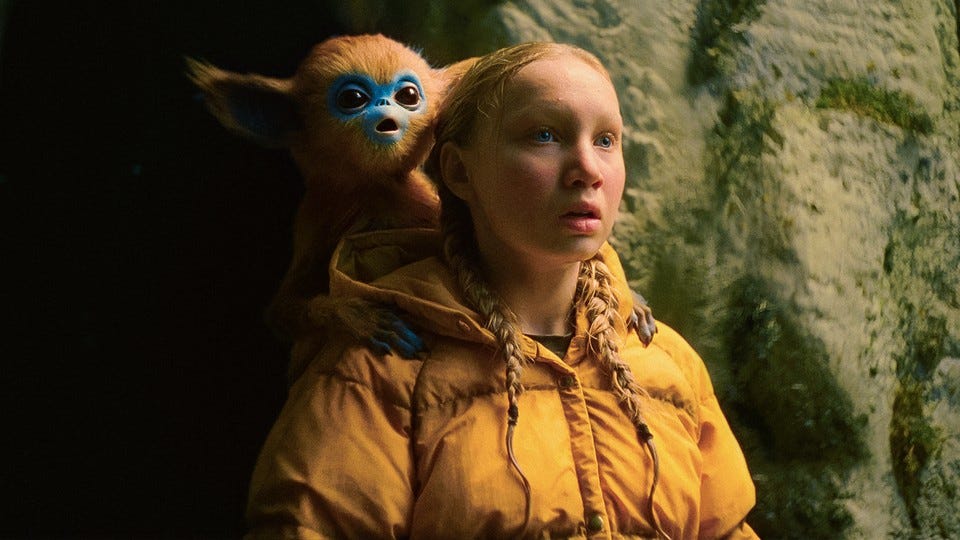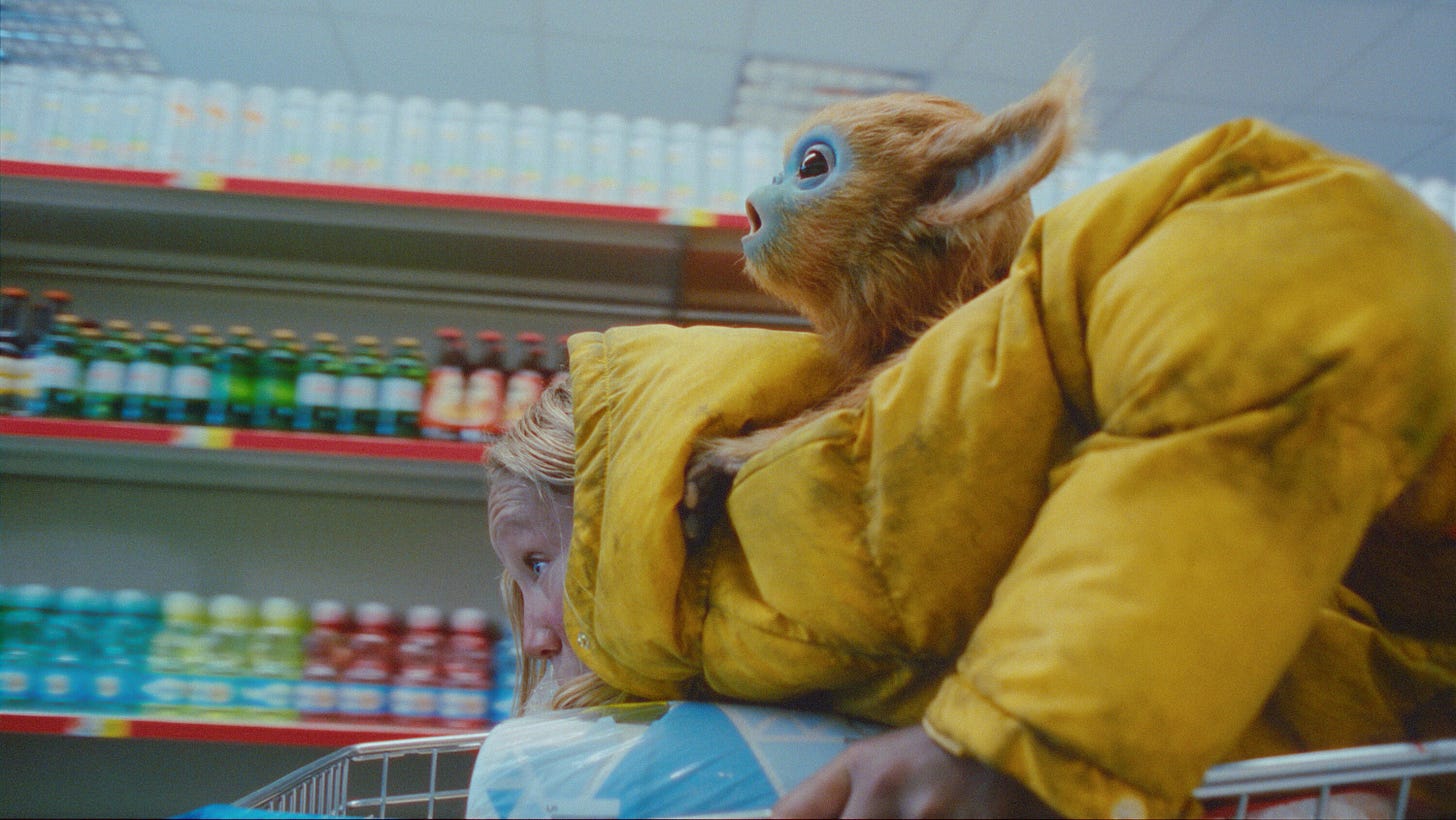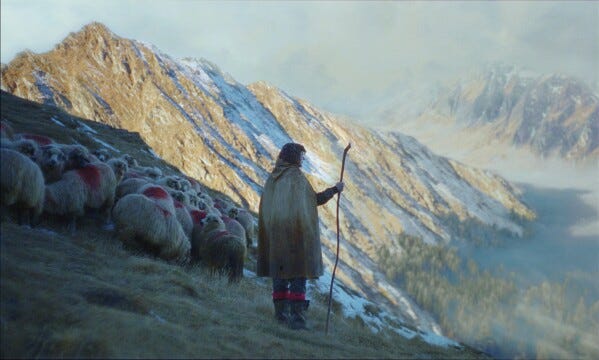'The Legend of Ochi' and the Ancient Implications of Animation
In which we reframe animation as neither genre nor medium, but a narrative suggestion all its own.
I’m just going to come out1 and say it frankly: I do not know how to explain to you all what’s been happening inside my brain since I watched The Legend of Ochi the other day. It just so happens, however, that it is my joy and my burden to try and explain anyway.
I suppose more accurately, a lot of what I’ll be saying here was already happening inside of my brain, but The Legend of Ochi has given me an opportunity to coalesce it all into something external and, dare I say, communicable. This is a contradiction; an attempted externalization of a necessarily internal struggle2 , which is therefore partially lost in translation. This contradiction defines all art and most writing. Remember that.
For those of you not in the know, The Legend of Ochi — written and directed by debutant Isaiah Saxon — stars Helena Zengel as Yuri, a young girl being raised by her tough, high-strung father Maxim (Willem Dafoe) in a village on the fictional island of Carpathia, where ape-like beasts known as the Ochi reside. Yuri, having grown up with horror stories about the Ochi, stumbles upon a lone baby Ochi in the forest one day and endeavours to return him to his family, forming a remarkable bond with the beast along the way.
Important to note here is the means with which The Legend of Ochi was brought to life. The film is famously a concentrated exercise in practical animation, with mass puppetry, animatronic work, and matte paintings all playing a role in creating this world and its inhabitants. It’s also a live-action film, which may seem to contradict my animation-centric title, but just bear with me here.
Anyhow, here’s what I’m positing:
Animation is the purest form of storytelling there is.
This, of course, requires us to consider what storytelling is and what it seeks to accomplish…
…which is a topic that The Legend of Ochi’s narrative speaks to.
First, let’s think about the implications that come with the presence of animation. Popularly, it’s associated with children’s stories, and is indeed always the safest bet when it comes to telling stories for children; certainly in terms of keeping attention and stimulating them.
Now, there’s been a visible cultural pushback around the idea that animation can only be for children, and it’s one that I’m staunchly in favour of, even though the very claim that animation can only be for children is one that I have trouble taking seriously. Nevertheless, I think we need to probe this conversation a bit differently — less pointing out how animation can be and often is for adults, and more questioning why we consider “for children” as something derogatory.
Because, really, do we not spend our whole lives yearning for a return to the purity of experience that we were capable of as small children? To filter the miracle of life through the senses of a child, who hardly filters anything, and therefore is constantly responding to something understood as miraculous?
And when we’re children, we like to read picture books and look at brightly-coloured designs and touch/interact with stuffed animals. We’re not drawn to language and logic systems, but to something more visually evocative, immediate, and esoteric.
Is it any wonder, then, that human storytelling began with cave paintings?
Moreover, are all of these things — picture books, bright designs, puppets and stuffed animals, cave paintings, etc. — not directly related to the craft of animation? It’s these same hand-made/drawn pictures and crafts that introduced us — as individuals and as a species — to storytelling, except now they’re moving around.
You see? Animation began with picture books began with cave paintings; the purest form of storytelling — fit for the supreme experiential ability of a child — maintained through the entirety of technological evolution.
Equally important of animation are the limitless visual possibilities of the frame — a film camera doesn’t create images so much as find and document them, but animation paints the whole thing direct from the imagination; the angles, the depth, the content of the image, the characters and their emotions, all of it.3
Therefore, not only does the medium of animation begin with imagination, but, presentationally, the only theoretical limit of animation is that same imagination — that same, purestrain emotional truth that you can only find deep in the mind of a human being.
The totality of animation begins and ends with imagination, whereas live-action stories — fictional ones included — buffer the element of imagination with real-world documentation via the camera.
As we’ll see further down, The Legend of Ochi does this very intentionally.
And what is fiction but a story that’s primarily — if not totally — bolstered by the emotional truth that it wishes to communicate, rather than historical facts or events that comprise non-fiction? Does animation, then, not embody the very essence of fiction to a degree that live-action storytelling couldn’t? Especially when you consider how deeply animation resonates with the basest, purest emotional sensibilities of a child? Or perhaps the first storytellers?
Indeed, how could we not understand animation as a rebirth of the picture book? A rebirth of the cave painting? The purest form of storytelling there is?
And what does the title card for The Legend of Ochi — this matte painting-backed, A24 family film — take the shape of?
A cave painting, and that’s only the beginning.
The thread that most will pull on is that The Legend of Ochi is a story about an ugly divorce, and Helena’s attempt to run from and then reconcile the reality that said divorce thrust her into — an emotional adventure sparked by way of the baby Ochi that needs to be brought home.
We’d be right to pull on that thread, but we can do the film one better by also recognizing that this is a story about a story — fractured into different languages and egos and mediums, and endeavouring to put itself back together as a song of pure emotional truth. The Legend of Ochi is a story divorced from itself.
Dafoe’s Maxim illuminates this right from the jump, and we can clock this by paying attention to the stories that he either buys into and/or peddles himself:
The story to his pack of 13-year-old hunters about how the Ochi took his wife, Drasa, who, in reality, left the family herself.
The story he tells Helena about the hunting knife he gives her, which he says was passed down to him from his father. Tellingly, he reveals later on in the film that it was bought at a gas station and he made that story up.
The story of the Ochi’s general savagery, which of course turns out to be false, as anyone who has watched a movie before will be able to anticipate.
Openly lamenting not having a biological son, only to scream “A father’s greatest treasure is his daughter!” when he convinces himself that Helena was kidnapped by an Ochi.
Telling Helena that he listened to her favourite band, and that he thought it was good, in a shallow and desperate attempt to lure her back home.
Maxim does not tell stories in hopes of illuminating his own emotional truth for the sake of being seen — he tells stories because he wants the people around him to behave a certain way, and so he creates the most convenient reality for that from his imagination.
Often, that sought-after behaviour is some form of submission — he wants Helena to stay in the village for her own safety, but also to keep her away from her mother. He wants his young soldiers to fall in line. He rhymes off a monotheistically religious gospel in the truck, hinting at his partiality to divine subordination.
He tells these stories because — like all of us — he is scared what might happen to his world if he doesn’t.
The moment he sheds his hunting armour before following Helena into the Ochi cave is a heavily symbolic one. The man-made contrivances of steeliness and control have fallen away, and he’s preparing himself for the vulnerability of pure emotional truth.
Then there’s the matter of the Ochi themselves, specifically the way they communicate, which is the least subtle part of the entire film.
DRASA: This song comes from the trees, Yuri. Ochi song. Their language is unlike ours. It’s more musical, more emotional. Yes, they have simple calls, names for things… But this is just the surface. Ochi communicate not in words, but in sensations. Joy, excitement, pain, fear. When they sing together, weaving their feelings through each other, a kind of miracle happens…
HELENA: I want that.
DRASA: Yes, of course. But, uh, it’s not for us.
As you can see, the Ochi song is something akin to telepathy — the transmission of a pure emotional truth, uninhibited by the constraints of language or the sheer impossibility of creating a perfect externalization of emotions, themselves necessarily internal. It’s no great task to thematically tie this to the idea of a divorce, often resulting from what is said but not meant, and meant but not said.
The individual body and wider community of the Ochi, therefore, are spaces where the story needn’t be at war with itself in the toils of language and ego. With the singing Ochi as its conduits, the story has no agenda of control like Maxim, nor does it risk not being understood, like how Maxim and Drasa don’t understand each other.
No, it’s a story being told and received by way of emotion in its purest form, set free, only intent on being witnessed by receivers who only intend to witness.
By basing stories in emotional control (or, more aptly, perpetuating a certain narrative in hopes of a response that favours you), we miss the point of stories.
And the point of the story — and, by extension, the storyteller — is to be emotionally understood.
It’s profoundly sad when you think about it; how much is lost in the imperfection of our available communication methods. How our bodies and languages will always distort our purest emotional truths. How we’re all, in some respect, always trapped by a language barrier, never being fully known.
And indeed, so too is Helena — on top of her reclusive, elusive nature — caught in this incongruent storm that rages between the foreground of her father and the background of her mother. Her salvation? Discovering that she can speak Ochi, which leads to what’s almost certainly the first harmonious relationship she’s ever been a part of, or even witnessed.
Her mother warns against keeping the Ochi as pets (i.e. controlling them) because she fears that the stink of man (or, symbolically, man’s imperfect ceiling of communication) will cause them to be rejected from their families.
She laments that man has “turned wolves into lapdogs.” Maxim’s soldiers wear pins adorned with a metal wolf bust.
More broadly, the film itself is an imperfect swirl of mediums, trying desperately to find its own equivalent of the Ochi language. Matte paintings and puppets birthed from the ancient, emotive depths of imagination that all animation is, offset by the physiologically, soberingly real human faces and environment that exist prior to the imagination, and therefore muddy the emotional truth.
Put another way, The Legend of Ochi is a film about the inevitable loss that comes with communication, and upon reckoning with the purity of emotion that animation (again, such as the paintings and the puppets) represents, we can recognize that that loss of clarity — that imperfect filtering of our emotions — is what makes us human. Real, live-action humans, who perhaps paint their emotions when words fail them.
Or maybe they make a film.
And here’s where we tie it back into the opening paragraphs, folks. Because is film — and all art, really — not an exercise in communication that’s doomed to be misunderstood or otherwise dismissed by someone?
Because The Legend of Ochi, for instance, is a pretty generously-scripted film. How did Helena get the baby Ochi in her backpack when he’s still pretty aggressively wary of her when he’s in her room? How did Helena possibly manage enough momentum to glide stomach-first on a shopping cart from one end of the store to another, and manage to crash through the window? What miracle of physics caused Maxim to get his leg trapped under a log in that cave?
All valid questions, and it wouldn’t be unfair to judge these as narrative oversights on Saxon’s part, but to dismiss the film on account of stuff like this misses the point of what a story is trying to do, which is communicate.
Because, frankly, one can reasonably imagine Helena luring the Ochi into her backpack with bugs, him getting comfortable in the leaf bed she makes, and then sleeping the whole way to the house in said backpack. Even if that’s not exactly how you logic your way through that plot point, it’s nevertheless a very doable task; you just have to be willing to bring your own imagination to the table.
If you’re not willing to do it, where does it end? Who’s to say you won’t write something like Man of Steel off because you feel the choreography of Superman’s flight is inconsistent? Erin Brockovich because the amount of legal speak is either too much or too little for you to buy as realistic? Interstellar because the science isn’t exact? Challengers because its depiction of tennis takes a few liberties?
All of those gripes would come from a place of ego; “the film doesn’t satisfy my criteria or experience, so I refuse to see what it’s doing.” This is Maxim-coded thinking; that the film must be subordinate to your world before it’s allowed to say its piece.
But a story exists to be emotionally understood, and therefore relies on two imaginations; the one that externalizes it, and the one who receives that externalization. What responsibility, then, do we have as viewers — the people that receive these stories? What threshold of imagination is the film asking of us? Is it too much? Too little?
But then, do we not have everything to gain by experiencing stories with the high-flying imagination of a child?4 Indeed, why would you ever not want to understand a story as purely as humanly possible? Why needlessly create a barrier out of The Legend of Ochi’s generous plot when the story — one most aptly communicated by the presence and execution of its animation × themes rather than the plot — is offering an emotional perspective that’s so transcendental?
Hell, the occasionally-creaky plotting even helps to point us in the direction of the emotional understanding that we ought to seek from this film. Any film.
Merriam-Webster defines “legend” as “a story coming down from the past, especially one popularly regarded as historical although not verifiable.”
Not verifiable, yet popularly regarded as real. That’s fiction; a story built upon emotional truth. That’s The Legend of Ochi.
That’s a cave painting.
That’s a picture book.
That’s animation
That’s imagination.
That’s human, and messily so.
Happy Pride btw
This line of thinking, courtesy of one Richard Kemick in his book I Am Herod.
So obviously The Legend of Ochi is a live-action film whose animated elements largely rely on being captured by a camera. This whole first section is purely to get us thinking a bit deeper about the nuances of animation so as to better grasp the film’s storytelling strengths later on (although I would argue that the puppet is every bit the direct-from-imagination phenomenon that a proper animated film would be; the matte paintings certainly are).
Which, by the way, needn’t require a surrender of our adult sensibilities and literacy whatsoever.










As a lifelong comic book reader, can I just say how annoyed I am that you don't even mention that art form once? :P It's arguably the FULLEST merging of drawn image and text we've ever invented, where even the linear nature demanded of animation isn't a given.
One of the best inversions of how illustration/drawing separates us from mundane reality - Calvin & Hobbs, where Calvin's imaginary worlds are drawn in a moe realistic style before returning to Calvin's "real world" which is completely cartoon-y. And yet it works without even having to think about it. The way we take to visual language that represents the real world in a shorthand way, but then allows us to explore those shorthands at a deeper level because we're not constrained by the said real world.
"Animation is the purest form of storytelling there is."
Yes, exactly! It's easier to accept animated films as fictional "stories" than it is for many live-action films precisely because there is enough distance between the art form and "reality" to make that possible.
And it does need to be "reframed", particularly in light of the increased volume of production of it being made around the world in the 21st century, thanks to technical innovations like the ones in this film.
As a historian, I have been exploring how animation both then and now has shaped popular concerns and cultural change without always being recognized for it. It's a topic I deal with in my books "America 'Toons In" and "The Encyclopedia Of American Animated Television Shows" as well as in my Substack FOCUS!: https://focus966.substack.com/